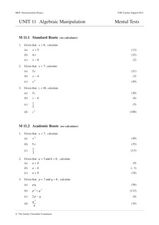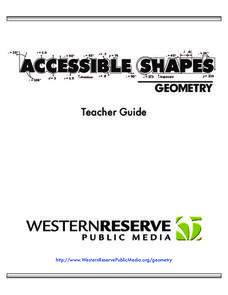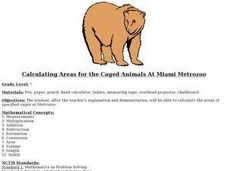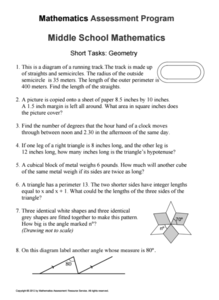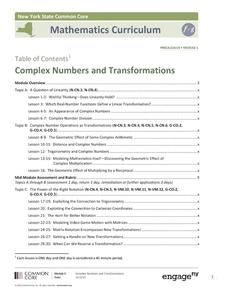Curated OER
Perimeter of Shapes
These squares and rectangles have length and width measurements with decimals; can young geometers determine the exact perimeter of each? Using a step-by-step example as guidance, they show work to find the perimeter of each of these...
Flipped Math
Unit 9 Review: Factoring
Make it complete. Pupils work through 16 problems to review factoring. The problems consist of straight factoring of polynomial expressions, solving equations by factoring, and applying factoring to real-world problems.
Curated OER
Perimeter, Area and Volume
In this geometry worksheet, 10th graders solve problems by finding the perimeter, area and volume of polygons. There are 17 questions with an answer key.
Curated OER
Area
Young scholars solve problems involving area. In this geometry lesson plan, students calculate the area of an object and relate it to the area of the ocean. They define what exactly and area is and then solve problems relating to the...
Curated OER
Algebraic Manipulation
In this algebraic manipulation worksheet, students examine a given number grid, find the pattern and determine an equation to fit the situation. They calculate the area of given rectangles. Students solve real life problems using given...
PBS
Accessible Shapes
All the 2-D and 3-D measurement work you need is in one location. Divided into three sections, the geometry lesson plans consist of visualization of three dimensions, classifying geometric figures, and finding surface area and volume....
Curated OER
Square Roots
Learners differentiate between perfect roots and rational roots. In this algebra lesson, students perform operation using roots. They add, subtract, multiply and divide rational expressions.
Curated OER
Calculating Areas for the Caged Animals At Miami Metrozoo
Seventh graders calculate the area of certain cages at the Miami Metrozoo after observing a teacher demonstration.
Curated OER
Finding Areas of Polygons- Extra Practice Worksheet
In this geometry worksheet, students practice finding the area of 11 polygons using diagrams which include units in both standard and metric measurement. They solve for the area of 11 polygons using words that describe the polygons that...
Curated OER
Science Crossword Puzzle
Class members read 25 clues about all areas of science, including biology, chemistry, weather, physical science, and insert their answers into a crossword puzzle. There is no word bank and the students would need experience with tough...
Curated OER
Perimeter and Area of Rectangles
Sixth graders solve for the area and perimeter. In this geometry lesson, 6th graders investigate polygons and use a formula to find the area and perimeter. They find the area and perimeter of various polygons.
Mathematics Assessment Project
Geometry
Help learners find joy in facing mathematical challenges. The questions posed on this worksheet encourage young mathematicians to utilize skills learned throughout a geometry unit, and to apply themselves and persevere through problem...
Curated OER
Trigonometric Ratios
In this trigonometric ratios worksheet, students determine the value of trigonometric ratios. They find the area of triangles, determine the length of one side, and compute the degrees in an angle. This five-page worksheet contains 55...
Curated OER
Word Problem Practice Workbook
Need worksheets that challenge your middle schoolers to apply their understanding of math? Problem solved! From integers, fractions, and percents, to algebra, geometry, and probability, over 100 pages of word problem worksheets are...
Curated OER
Development of Industrial New Hampshire
Students work in groups to research and share information about several different topics that were part of the development of Industrial New Hampshire. Students complete five parts of the project which include researching, role playing...
Curated OER
Grade 3: What Can I Make with 30 Centimeters?
Third graders create polygons with perimeters of 30 centimeters, use the centimeter grid paper to determine the area of each shape, and organize the shapes to make generalizations from the patterns they see.
Curated OER
Working with Rates
In this working with rates worksheet, students solve 9 problems where they find the rates, they solve 5 problems where they find the rates for compound units and they solve 5 problems where they find the rates using scientific notation.
West Contra Costa Unified School District
Division (No Remainders)
Help young mathematicians build a solid understanding of division with this base ten block activity. With the help of these popular math manipulatives, children model different math problems in order to reinforce the connection between...
EngageNY
Polynomial, Rational, and Radical Relationships
This assessment pair goes way beyond simple graphing, factoring and solving polynomial equations, really forcing learners to investigate the math ideas behind the calculations. Short and to-the-point questions build on one another,...
American Museum of Natural History
What Do You Know About Astronomy
Develop an understanding of the universe. Learners answer 10 multiple choice questions about several topics in astronomy. Questions contain information about the age of the universe, gravitational attraction, galaxies, planets and comets...
Curated OER
Keeps on Pumping
Students measure and calculate heart rates per minute and for other units of time. They determine the amount of blood pumped by their heart during various intervals of time.
EngageNY
Complex Numbers and Transformations
Your learners combine their knowledge of real and imaginary numbers and matrices in an activity containing thirty lessons, two assessments (mid-module and end module), and their corresponding rubrics. Centered on complex numbers and...
Mathematics Vision Project
Module 5: Modeling with Geometry
Solids come in many shapes and sizes. Using geometry, scholars create two-dimensional cross-sections of various three-dimensional objects. They develop the lesson further by finding the volume of solids. The module then shifts to finding...
Curated OER
Inductive Reasoning
In this algebra worksheet, 10th graders apply inductive reasoning as they figure out the next number in the sequence or pattern. There are 53 problems.






